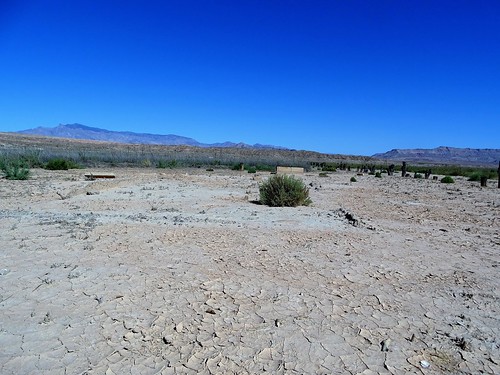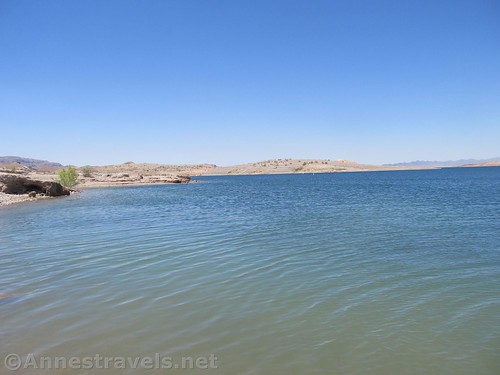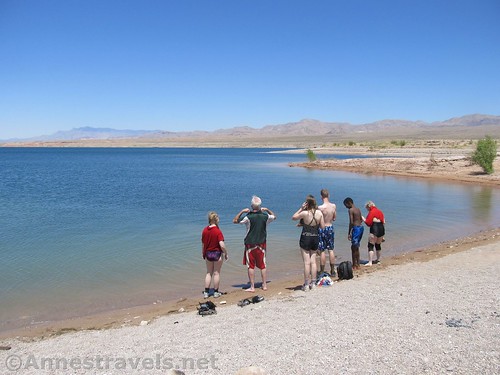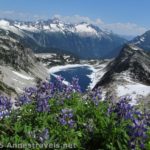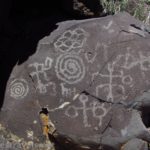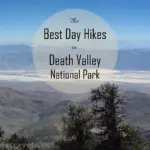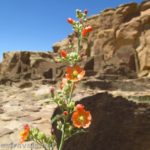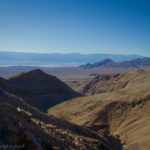I’ve gotten a bit serious over the past few weeks on Jesus Sees the Wilderness, so here’s a story that’s hopefully a little lighter – if also a bit longer.
When the sun shines in the desert, it becomes hot.
Especially if it’s the end of June, it hasn’t rained in weeks, and the ground has already been parched, every ounce of moisture drawn out until even the plants wilt, stark against the sandy earth, holding onto the water from the last rain, the last dew, any drop to be found, in hope of survival until the monsoons begin to wash away the deathly dryness.
We drove through Nevada, the desert stretching away in every direction to end in treeless and grassless buttes and cliffs. I had no information, only a map and a tour book, courtesy of the American Automobile Association. Of maps produced, of tourists guides, AAA makes some of the best. But even they aren’t prepared for a van full of people to decide they want to swim at a secluded and probably deserted cove of Lake Mead on their way to Las Vegas to get cheap gas before crossing the border into California.
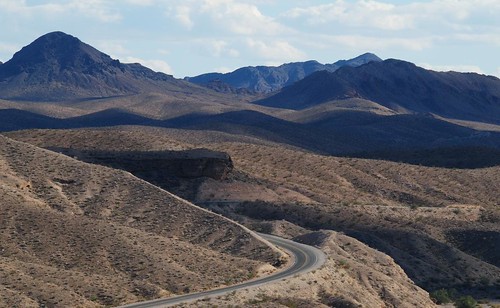
Route 167 heading for Las Vegas. Photo credit Andrei Taranchenko
The map was great as far as it went, directing us off the highway and toward Valley of Fire State Park, indicating at least one swimming cove on the shore of the lake, not to mention a few other interest-inducing dirt roads. And we had swum in the area – somewhere – some 16 years before.
What could possibly go wrong?
But anything in Nevada in the summer is a chance. Flying along the two-lane highway at 55mph, the desert stretched away in nearly flat, sand-colored plains, dotted with the dull grey-green of stunted mesquite and sage brush to sand-colored buttes and formations, crazily formed and eroded into towers and temples, pyramids and pinnacles. Further from the interstate, further from what little civilization existed between Salt Lake City and glare of Las Vegas. Few would want to live here. Few would be crazy enough to try.
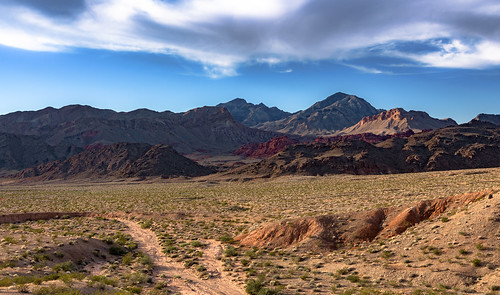
Buttes, castles, and pinnacles – Photo Credit tom_stromer
I couldn’t shake the feeling of isolation – not aloneness, like on a hike in the mountains without another soul for 50 miles in each direction – but isolation, like we were driving into a place no longer inhabited, forgotten, pushed out of the memories of any who had come before us as uninhabitable, unusable, useless, except for beauty.
We passed the sign – and a freshly-paved parking area for picture-taking – informing us we were entering Lake Mead National Recreation Area. Not that the lake was in view. We couldn’t even tell where it was supposed to be; no greenery marked its shores and no blue or even brown water showed between the hills and the flat tableland.
Further along, a massive adobe entrance fee station had been erected. It stood empty now, thick adobe-like walls soaking in the sunshine, its multiple lanes empty and blocked off. I wondered if it was ever used, or if it was only in service during popular times of the winter, fall, and spring.
Right next to the fee station, a sign pointed down a dirt road in the direction of “St. Thomas Cove”. Quiet and secluded, likely, on the edge of Lake Mead, a beach rarely used and never in the summer. It sounded good. So we turned off the pavement onto the gravel road.
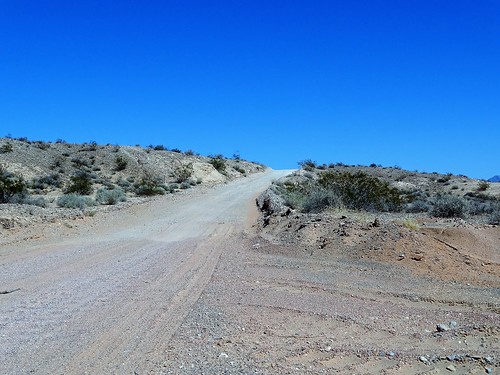
The road to St. Thomas Cove – photo credit billy kerr
The road was long and winding through the desert. If the feeling of isolation had been present on the highway, it was stronger here, but more adventurous. The sun was no less scalding, the desert no less dry. We were on a road less traveled; a road that did not need life on it to exist; a road meant for adventure.
At last the road ended in a small, sandy parking area atop a bluff. We filed out of the van to gaze over the edge to get a glimpse of where we would soon be swimming in the cool waters of Lake Mead. Miles, as far as the eye could see, the sage brush, mesquite, and Mormon tea stretched across the desert plains. The Muddy River (its name; not our name for the trickle) wound down the valley. But that was it.
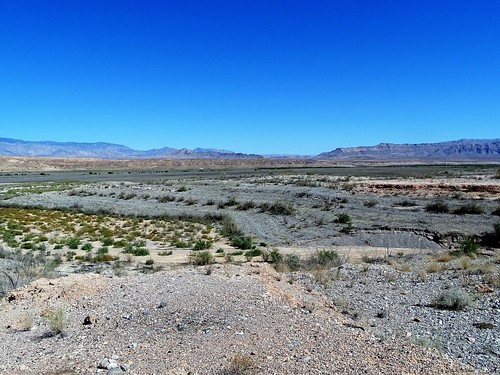
Where Lake Mead was – photo credit billy kerr
We gazed, a little bewildered, more than a little disappointed, at where Lake Mead had once been. I felt a giggle tickling the back of my throat; here we had driven all this way, and all that was at a cove was a sea of sage brush. One look at my companion’s faces, and the giggle died with the tickle. They were not happy with a sea of sage brush.
There is little more devastating than to drive toward your dream, to live it and dream it and work for it, only to arrive and find that the very dream you longed for has dried up and receded. It is no longer in sight where you knew it would be, and all that is left is the floodplain, lifebloodless as a dream that has died, dry as a mummy, and hopeless as a land without water.
None of us were going to scramble down a butte onto a flood plain in Nevada in 100+F heat in the middle of the day in the middle of the summer to find a lake that wasn’t there.
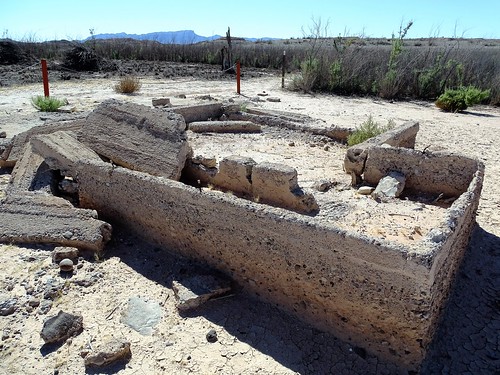
Ruins at St. Thomas – photo credit billy kerr
St. Thomas, it turns out, was a Mormon settlement in 1865, named after (it is to be supposed) the party’s leader, Thomas Smith. (Perhaps he was not a saint, but there is more than one way to name a town after one’s self.) The town and other settlements along the Muddy River prospered into the 1870s, when a US governmental survey shifted the boarder of Nevada a degree longitude to the east in 1871.
The Nevada state government must have rubbed its hands together in glee at the prospect of another prosperous settlement within its territory. And so, in the footsteps of Rehoboam, the state officials devised an unfailable plan to establish its control over the region. Tax collectors were sent out to require all the 500+ citizens of the “Muddy Mission” to pay taxes – in gold – for the years previous, all the taxes overdue for their years along the Muddy River. But like Israel, the Mormons would not be pushed around by high-handed, controlling kings – or governments – from far away in the state capitol.
And so the entire community abandoned the settlement, leaving the tax collectors empty-handed, and settled in Utah, mostly in the modern towns of Glendale, Orderville, and Mount Carmel.
Several groups rebuilt the town of St. Thomas over the years, but the final residents left in 1938, as the rising waters of Lake Mead overtook the town. The National Park Service grabbed the opportunity to claim the road and proclaimed the area St. Thomas Cove.
Now, as the water as receded in recent years (due to drought, changes in the atmospheric conditions due to the lake’s creation, and who knows what all else), the town’s ruins are again high and dry. A trail from the parking area leads to the townsite.
But the state’s somewhat-ancient history wasn’t on my mind as the tableland and low, grey, distant mountains rushed past the van windows. I wondered about Lake Mead, if any swimming areas were left, if we would find the beach we longed for. The sun glared down on the van, and even its grey roof was not enough to keep the rays from heating it to oven-like temperatures. Every window was open to its fullest extent; the air rushing in felt as though it was blowing from an oven, scorching our faces, blowing back our hair, drying the sweat before it had a chance to exist.
When a dream has died, hope dies with it. Even facts don’t always make sense and can’t break in to shed light that would blow the embers of hope back to life.
At last, on a slight rise, a median splitting the highway, and a sign pointed left to Echo Bay.
The access road was paved, this time, and much shorter than the winding road to St. Thomas, invisible in the brush of the desert. It was straight, narrow, almost-abandoned, and stark, heading straight for pinnacles that could have been in the Grand Canyon, a narrow line of desert peaks, grey and red-hewed in the blinding sunlight.
And then, below us, far, far below us, were the blue waters of Lake Mead.
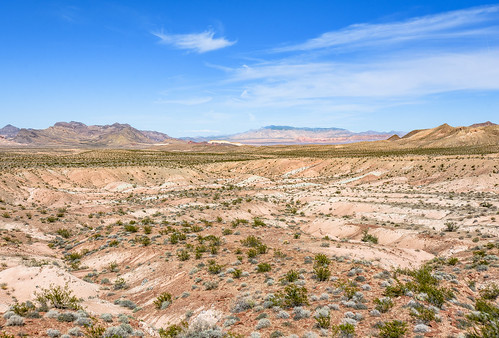
A line of blue, marking Lake Mead – photo credit tom_stromer
At first it was just a line of blue offset by the white mineral line of the lake’s high water mark. But closer and closer, the water took shape and became the lake we had longed for, sparkling blue in the near-high noon sunlight.
Hope deferred makes the heart sick. But a longing fulfilled is a tree of life. (Proverbs 13:12)
The road stretched on, but we didn’t care. The lake we had longed for was in sight. We still didn’t know if we could get to it, but there it was, in front of us, our dream, and we would get there somehow, by hook or by crook.
When at last a dream is at last breathed back to life, its furry is twice as hot, twice as strong. We were going to find a way to that lake.
In its day, Echo Bay was a resort, perhaps not for the rich and famous – even if rather colorful casino business owners first developed it in the 1960s for their own secluded weekend pleasure – but made for average families and individuals who wanted beauty and recreation in the desert. Then, the campground was busy, the hotel full, the marina packed with boats both in use and in storage. There was even an airplane runway, houseboats for rent, and plenty of smaller boats to rent as pleasure and funds allowed.
It is even said that eBay, the auction site, was named after Echo Bay – its creator wanted echobay.com, but as that was already in use by a Canadian mining company, he settled for eBay. Pierre Omidyar had long used the marina, finding the area quite beautiful and the name “cool”.
The road turned to gravel, an addition made by the park service to access the new boat ramp, constructed in 2011 after the old boat ramp ended in a dry wash. Still the lake was out of reach, and still the road wound downward.
Then, beside an ancient looking primitive restroom – 1970s yellow – the road widened, blinding white. A few boat trailers and even fewer vehicles stood silently alone; no one was about. We pulled up at the end, and Daddy and I hopped out to case the joint.
I squinted against the noontime glare, the sunlight reflecting off the near-white gravel and sand. Walking the parking area was like walking across a white electric griddle, ready for pancakes. We scrambled down an embankment, and there was the water.
We dabbled our fingers and wandered the beach. The water was cool; it was real; the beach was nicely gravel, without mud.
Twenty minutes later, I was in the water, swimming from one end of the little bay to the other, almost completely submerged in the desert’s coolness; its healing, life-giving oil of the gift of water. I had waded in this river’s water the day before, in Zion’s Narrows – the Virgin River flows through Zion and then into this arm of Lake Mead. There, too, it had been refreshing and life-giving. That had been beautiful, but this was stark, the contrast of life and death, of heat and coolness, of blinding sun on red and white and grey and sand-colored hills contrasting with the deep, clear royal blue of the lake and the azure-cobalt of the sky, hazed by the brilliance of the sun.
A motorboat buzzed by out on the lake, but here in this sheltered cove we barely heard it, barely noticed anything more than the ripples as they washed ashore. We soaked in our dream, soaked our (closed) waterbottles in it, saturated ourselves in its coolness – our dream come true.


